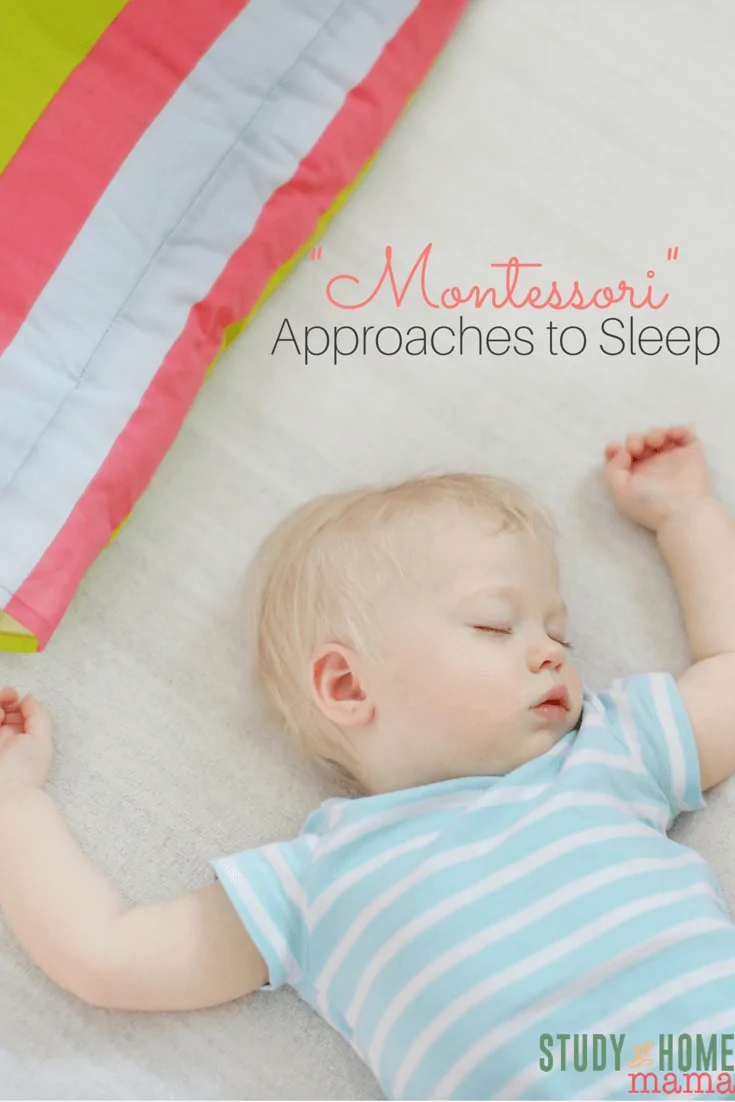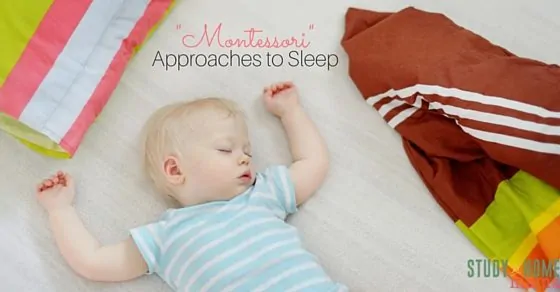Montessori Approaches to Sleep
When people attach the term “Montessori” to sleep, its often in reference to developing independence around sleep and bedtime.
Its important to note that Dr. Montessori never wrote about sleep and that there is no singular approach that all Montessori-style parents (or teachers) agree upon.
The main concept is to trust that children can be empowered to follow their hormonal sleep window and allow them to self-regulate. Montessori sleep methods can be successful with problem sleepers and easy sleepers, as long as you choose a method that you feel comfortable with and that is a good fit for your child’s personality.
My top three tips when implementing any of the sleep methods described below are:
- Stick with it for at least a week. Don’t expect anything to work in three days or less, some changes and some children need at least a couple of weeks to adjust.
- Do not make sleep a consequence or a punishment. Keep it positive. Lots of love, cuddles, and soothing rituals and traditions help make bedtime easier for children, and parents.
- As with all things Montessori, follow the child. More on that below.
Floor Bed
The most widely discussed Montessori sleep arrangement is the floor bed, a crib- or toddler-sized mattress either placed directly on the ground or upon a low bed frame. The idea behind this is that children can independently access (or exit) their beds at any time, requiring that the bedroom be fully child-safe. For some children, this is a great arrangement and for others, its simply too much freedom.
(And there is nothing saying that if you want to co-sleep, that you can’t make your own bed a floor bed!)
Playing to Sleep
Another concept is “playing to sleep” which allows children to have access to books and toys at bedtime and giving them freedom to determine when they are ready to fall asleep. There are still some rules and for each family this is different; for us, Ella must choose her books and toys before getting into bed and is not allowed off of the bed after lights out. I also only allow “silent” toys, ones without batteries, buttons, etc. I will admit that Ella took hours to fall asleep when we first embraced this approach (singing and playing until 10pm some nights), but she slowly returned to an earlier bedtime.
I will admit that this was perhaps the most difficult method that I tried — there were many times that I was tempted to limit her play or have her put a toy away. However, trusting the method, after less than two weeks the novelty wore off and the toys did a great job of providing security and a point of interest that made bedtime attractive.
Nighttime music
Nighttime music is not generally considered Montessori, but I found it helpful while transitioning Ella to independently falling asleep. It gave her something to focus upon while also being soothing and something special for bedtime. (It also allowed me to keep track of how long the sleep process was taking!) Nighttime music should be instrumental and melody-based — no singing and symphonies to potentially break the lull of the music.
Skin-to-skin and Essential Oils
This can start off at a young age as baby massage and either remain as massage as children get older, or adapt to something as simple as rubbing their backs or drawing on their hands with your fingers while reading a bedtime story. There is amazing proof that skin-to-skin contact with loved ones is essential for children in emotional regulation and is incredibly calming before bedtime. You can even put an educational spin to it if you’re more comfortable “spelling out” letters and words on your child’s hand and having them guess what you’re “saying.”
Some parents are huge essential oil advocates and this is a great time to integrate it into your child’s day. I would love to incorporate these more, as I only reach for them when we are sick, but I can’t say enough how helpful peppermint oil has been when Ella is congested and trying to sleep.
Choice
For us, Montessori bedtimes also involves choice — between my bed and her own bed. It is a very modern and Westernized concept to have separate family beds for such young children, and while I do not want to engage in a debate on (safe) co-sleeping, it has worked for us from newborn to preschooler. Ella sometimes chooses to start off the night in her bed and sometime after I have gone to bed she will climb in with me. I no longer have a floor bed, as I did when she was younger, but I have provided a trunk for her to easily step up onto. Regardless of where your child sleeps, the room and set-up must be safe.
Choice can also relate to choosing stories, pyjamas, etc. Keep in mind that if you are getting children into their bedtime routine at a decent time, choice will be a smooth and positive thing, whereas overtired children may not be able to handle any degree of choice — it will be overwhelming.
Stimulation
An essential aspect of Montessori-style bedrooms is that they are not over-stimulating in themselves. While children can engage in hours of play within them, the rooms themselves should allow for peace and relaxation. Some elements that might be appropriate for day might need to be removed or altered during the night, for example, stereos, moving furniture to avoid accidents, etc.
Above all else, Montessori is respectful and follows the child. We empower and teach children concepts and responsibilities when they indicate that they are ready. Some children need assistance longer than others, and while it is every parent’s individual decision, the Montessori way takes into account the needs and preferences of the child; children are not forced to comply with sleeping arrangements or expectations that they are insecure or upset by. That is not to say that a child gets a say as to whether or not they are going to bed — they don’t — but rather, if a child feels unsafe going to sleep without a light on, or a parent present, etc, we acknowledge that forcing the child to comply with our (well-intentioned, well-informed) bedtime design can be counter-productive and doesn’t occur as empowering to the child. It may help to think of it like eating: we don’t let children choose whether or not to eat, but we don’t force a child to use a spoon who isn’t ready. We may provide the spoon as a choice, and show them, but we aren’t going to sit and watch a child not eat because they aren’t ready (or don’t feel ready) to use a spoon.
Its also important to incorporate some routine into sleep — as in all parts of the day. Routine is reassuring, and when children can accurately predict what will come next, they feel more confident and comfortable settling into their bedtime.
I’ll be discussing hormonal sleep windows more soon, but I think its too much to add onto this post. What are your thoughts on children’s sleep?
Want to read more about Montessori parenting? Check out our Montessori Approach to Potty Learning or 6 Tips for Raising Internally Motivated Children.





I love this approach. I found the CIO methods to be severe and frankly… sad. I couldn’t stand it. Every night, I lay down with Little Bee to help him fall asleep. I take the time to be there with him so that he feels safe. As soon as he drifts off, I quietly leave. This works for us. Thanks for sharing.
I’m a huge advocate of cosleeping, whether for the beginning of the night or the full night. I have a few sleeping posts in the work, and hope I can muster up the courage to post more about cosleeping 🙂
Hey ! Thank you for this post , I totally loved it . Is there a good way to do a sleep training for a 9 mo baby using a Montessori bed? For now we all co sleep on the floor ( thought baby has his own separate mat ) but he tends to wake up often and needs us to go back to sleep … Thanks ???
My baby is 9months now same situation. How did you end up making it work ? Thanks
My 10 months old also needs help to sleep. We turn off lights but he still wants to play with his toys until he’s overtired and starts to cry. At that point only rocking him in our arms would make him sleep. Any tips to make him sleep by himself? I don’t mind staying with him, just want him to develop a better approach than play until overtired as it affects the quality of his sleep. Thanks a lot!
So, playing to sleep is a tricky one at this age, especially with children who resist sleep. (Some children naturally slow down and eventually give in to sleep, some children will fight til the very end.)
What is his current set-up? When the lights are turned off and he’s playing, are you present in the room or is he by himself?
Hello! I am having the same situation with my 10 month old. She has a full size floor bed, dark room, round machine, silent toys, etc. It seems like everything is in place for sleep but she cries and crawls around the room screaming. I don’t let her cry for more than 15-20 minutes so I go back in, rock her, then she will either fall asleep with me or will start the whole tantrum process again. Her naps are what we struggle with the most (2X day). Please help!
Thank you for explaining this! My kids are past this point but I have always wondered how you would Montessori sleep.
You’re welcome, Amy!
We haven’t had any issues with our little one falling asleep, but it’s good to read these strategies for when the time comes, as she gets older. We loosely follow the play to sleep concept. Our daughter has a bed time that as we near, I start to watch for her sleepy signs. Once she starts showing those we start our routine. I find that she may be really sleepy prior to getting in her crib, but the minute she does, she wants to play! So I just let her. I figure she’ll settle back down when she’s ready! Thanks for sharing! Katie @ The Cup of Tea blog
Love that, “sleepy signs.” I’ll be posting more about hormonal sleep windows next week and I might have to borrow that term!
Thanks for braving this topic, Jennifer — it’s one that’s old battleground for “mommy wars.” Maybe because sleep is something we all so desperately miss from our pre-child lives!
Thanks for a lovely, thoughtful and useful post. I love the concept that bedtime includes choice — I guess it does in our home too, but I had never thought of it as so intentional.
Thank you, Meghan 🙂
I think when you become so dedicated and ingrained into a lifestyle or mentality, even the things that aren’t so intentional often are still informed by that commitment.
Great blog with information about sleep. I am always fascinated about the topic 🙂 I will whole-heartedly admit that we did use the Babywise method from about 6 weeks onward. It did involve some crying before sleep, but for the most part, there was minimal fuss or crying before naps or bedtime so long as we properly timed the ‘sleep window’ like you mentioned, followed his cues, and remained very consistent. We enjoyed a lot of success with the method, but it is certainly not for everyone. Our bedtime and nap routines are simple and straightforward, and I agree with you that doing calm things before bedtime is so important.
I also really enjoy what you said about routine offering assurance and instilling confidence and comfort in children. And while we do follow a rough schedule in our home everyday (it’s just what works best for our family), flexibility and listening to your child is key. I also really like the idea of a floor bed, it is exactly what we were intending on doing once we decide to transition our son to a twin bed from the crib. Thank you for this thoughtful and informative post.
Thank you for such a thoughtful comment, Lauren! Sleep is such a tricky topic, I think no matter what method a family employs, we all have similar intentions — to give our children the GIFT of good sleep habits! I think I also need to write a post about sleep dependency and how to ease away from it.
Could you go into a bit more detail on what your bedtime routine looked like back when you wrote this? I have a 2.5 year old girl and we’ve always had a hard time getting her to sleep (from baby on unless she was nursed to sleep) and have always had the idea she should be capable of going to sleep when she’s ready. We’re moving soon so obviously were not trying anything new until we’re settled but I really want to get away from our current method of always staying until she is unconscious. Just found you blog and I’m loving it, thanks for sharing!
Thanks so much for your comment, Joelle! Happy to have you!
I’ll be the first to admit we’ve had more than our fair share of sleep problems! I also nursed my daughter to sleep for awhile, and due to her auditory integration issues, we’ve had rough patches.
I’ll write a new post on this shortly — I’ve been meaning to for awhile, but I think with developing a new sleep routine, the first thing I need to say is that it can easily take a month to really get everything sorted out. Figuring out which rituals or sleep aids work for your child, and helping them adjust to the new expectations is hard. I slowly transitioned from nursing her to sleep, to lying beside her and gently stroking her face as she fell asleep, to sitting at a desk in the same room, to eventually giving a good night kiss after our bedtime ritual, turning on her sound machine, and leaving the room.
There were tear-filled nights, and it was really hard to not feel like I was being a big mean mom, but I lovingly assured her that she was fine but she needed to stay in bed, and sometimes I would set a timer and lie down with her for an extra three minutes (that way the timer ends it and not me — I used to not be a fan of timers, but they work for us now). Sometimes letting her hold onto something of mine helped, too.
Our bedtime routine now (at 3.5 years) is:
7pm -final play in the playroom with a five minute timer on my phone
7:05 -bathroom and pjs
7:10 -read a book and talk about our day a bit, answer questions or concerns about the next day
7:20 – Facetime with both sets of grandparents
7:28 – final kisses, turning on the closet light and sound machine, tucking in her and her doll
Thank you! I really appreciate your response and getting a sense of some realistic exceptions as to how long this can take.
Good luck, mama 🙂
Great article. We did a floor bed with our now 5 year old and it worked great, it’s funny I never told him he couldn’t get off of it, but he still calls for us when he wants to get up.
Regarding the Essential Oils, please look into the danger of using peppermint oil. Tea tree would be safer. Also never use Eucalyptus on a kiddo.
🙂
Thank you for your comment! It is funny – I find that kids who start with no cribs but always an open bed don’t have the issues of escaping the bed the same as children in cribs do!
We dilute our peppermint oil before applying to her feet, and it’s been one of the few oils that has worked for my sinuses. I’ve actually experienced tea tree oil poisoning before, so it’s strangely the one I’m most cautious with. I definitely think that people need to do their own research and consult with professionals which is why I don’t discuss oils much on the site. I can only speak to our experience and what has worked for us.
My 2 y/o girl will actually pull me to the fridge to get her bottle (the only time she gets one) when she is tired. She usually starts getting fussy and I ask her if she’s tired and wants to go night night. Sometimes she says no, but mostly she will say baba and then walk over to the fridge to get the milk out if I haven’t started walking there. Then we walk to her room, where her crib is more of a daybed, and she will climb in. Usually I can give her a kiss, say good night and leave, but sometimes she will insist my hubby or I stay (points next to her bed and says ‘nigh nigh!’) And we will. We tried the cio method, and she would pou d on the door for a good 30 mins as though something was trying to get her, so why not just lay there and wait for her to sleep? We don’t even have to be in her bed, just next to it. She will most likely come into my room crying around 2, but once she’s in our bed shes fine. And if by chance I fall asleep in her room, all I have to do when she wakes up is pat her and sing moment or talk and she will go right back to sleep. I know I’m mostly lucky with her sleep, but we’ve put her down the moment she starts getting tired from day one. There have been nights where she will get up and be like nope, just kidding! And we let her stay up another 30 mins or so, but then she goes down again the same way and the 2nd time is always the winner!
Sounds like you’ve found something that really works for you!
One thing that I really tried to emphasize in this article and that I have discovered after caring for so many children is that the cliche is completely true – every child is different. I’ve had amazing sleepers and I’ve had children who scream and scream no matter what you do for them because they prefer being “tricked” into sleep (rocked slowly while watching TV, etc)
I think the only thing parents need to consider is 1. whether they are planning to put their child in care, and if that routine will work in a group environment (IE, I can’t rock each daycare child to sleep) and 2. if the routine will be feasible with more than one child. Personally, my daughter’s routine probably wouldn’t work with more children but I know I’m not having any more at this point in my life, so it works for us!
This comment is deleted because it’s SPAM.
This comment is deleted because it’s SPAM.
Thank you. Great post.
I want to thank you! I spent hours researching about toddler sleep in Montessori and I have found nothing useful!
Your approach helped me understand since we are now considering Montessori for our family. Everything out there is only about setting the room or how to continue doing Montessori but nothing about introducing sleep to the toddler and let them have control.
Thank you again this is gold!
Thank you for your comment – I’m glad it was helpful to you.
I’m a Montessorian myself, but bedtimes are a non-negotiable in our house. There are always going to be principals in any parenting philosophy that we need to look deeper into. I don’t think Dr. Montessori had it right in some places; letting children stay up to see the stars and rise with the sun…you don’t want to see my kids after a late night. Lol. (They wake up with the sun on their own.)
I agree that not every aspect of any philosophy is going to be a perfect fit for every family, and I think we are always better off looking at these things critically and deciding what fits our family dynamics and each individual child.
Is this in reference to the “playing to sleep” concept? I don’t necessarily think that it’s about negotiating bedtimes, it’s about embracing that children can take a while to fall asleep and providing an alternative to a parent being there throughout the process or providing boundaries, especially if your child is likely to wander out of/around their room for hours after the established bedtime. For one family, that can look like “you can have this book in bed with you” and for others it may look like free reign of the room.
Is there a contact for the author of this? I’m interested in learning more about playing to sleep so my child can start to self-soothe a little more and need me and her bottle less at bedtime. We currently have to bounce her and stay by her until she is mostly asleep. She’s currently 14 months old.